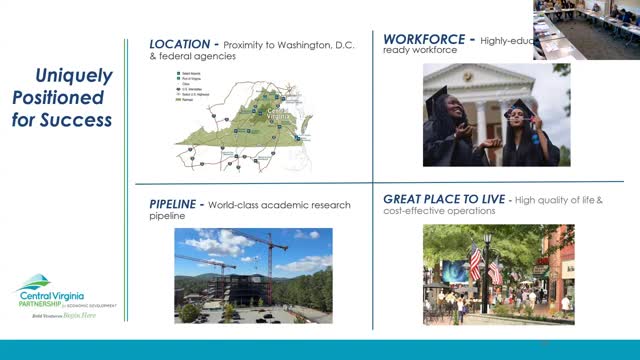Charlottesville, Albemarle economic plans and joint EDA groups identify workforce pipelines, infill redevelopment and shared metrics
October 23, 2025 | Albemarle County, Virginia
This article was created by AI summarizing key points discussed. AI makes mistakes, so for full details and context, please refer to the video of the full meeting. Please report any errors so we can fix them. Report an error »

City and county economic development staff presented their respective strategic plans and asked members of the City of Charlottesville Economic Development Authority and the Albemarle County Economic Development Authority to discuss areas for joint action.
Chris Engel, director of economic development for the city, summarized the city’s economic development strategic plan and its five goals, including entrepreneurship, intentional growth, and pathways to opportunity. Emily Kilroy, Albemarle County’s economic development director, reviewed the county plan and said the county’s top sector goals include national security/intelligence (leveraging Ravenna Station), life sciences, agribusiness and food processing, plus talent and entrepreneurship.
Following those presentations the joint participants split into small groups. Reporters from each group summarized discussion themes to the full meeting: the groups consistently identified workforce‑development pipelines and local hiring, redevelopment and infill in commercial corridors, and regional transit and housing affordability as areas for collaboration.
Several EDA members emphasized connecting incoming employers with local training and credentialing programs so residents can access career‑ladder jobs. Albemarle staff and other speakers pointed to existing initiatives—such as the BioBridge talent pathway and partnerships with Piedmont Virginia Community College (PVCC)—that are already addressing training and credentialing for life‑science and manufacturing roles.
City and county participants said they expect the Innovation Corridor planning work to further identify specific industry needs that can be aligned with education and training programs. The group also discussed how to measure outcomes: who will monitor metrics such as local hiring, displacement risk and housing affordability, and which agencies should be responsible for tracking progress.
Small groups suggested potential joint actions over the next 12 months: (1) coordinate workforce pipelines across city and county boundaries to avoid duplicated efforts; (2) pursue targeted infill redevelopment in specified commercial nodes to add housing and modernize obsolete retail footprints; and (3) share materials and site‑selector lessons learned from previous regional visits.
The joint meeting concluded with staff asking EDAs to nominate representatives for future collaborative activities and to continue sharing leads and data that inform site selection and local hiring commitments. The chairs adjourned the session and scheduled the next Albemarle County EDA meeting for Nov. 18.
Chris Engel, director of economic development for the city, summarized the city’s economic development strategic plan and its five goals, including entrepreneurship, intentional growth, and pathways to opportunity. Emily Kilroy, Albemarle County’s economic development director, reviewed the county plan and said the county’s top sector goals include national security/intelligence (leveraging Ravenna Station), life sciences, agribusiness and food processing, plus talent and entrepreneurship.
Following those presentations the joint participants split into small groups. Reporters from each group summarized discussion themes to the full meeting: the groups consistently identified workforce‑development pipelines and local hiring, redevelopment and infill in commercial corridors, and regional transit and housing affordability as areas for collaboration.
Several EDA members emphasized connecting incoming employers with local training and credentialing programs so residents can access career‑ladder jobs. Albemarle staff and other speakers pointed to existing initiatives—such as the BioBridge talent pathway and partnerships with Piedmont Virginia Community College (PVCC)—that are already addressing training and credentialing for life‑science and manufacturing roles.
City and county participants said they expect the Innovation Corridor planning work to further identify specific industry needs that can be aligned with education and training programs. The group also discussed how to measure outcomes: who will monitor metrics such as local hiring, displacement risk and housing affordability, and which agencies should be responsible for tracking progress.
Small groups suggested potential joint actions over the next 12 months: (1) coordinate workforce pipelines across city and county boundaries to avoid duplicated efforts; (2) pursue targeted infill redevelopment in specified commercial nodes to add housing and modernize obsolete retail footprints; and (3) share materials and site‑selector lessons learned from previous regional visits.
The joint meeting concluded with staff asking EDAs to nominate representatives for future collaborative activities and to continue sharing leads and data that inform site selection and local hiring commitments. The chairs adjourned the session and scheduled the next Albemarle County EDA meeting for Nov. 18.
View the Full Meeting & All Its Details
This article offers just a summary. Unlock complete video, transcripts, and insights as a Founder Member.
✓
Watch full, unedited meeting videos
✓
Search every word spoken in unlimited transcripts
✓
AI summaries & real-time alerts (all government levels)
✓
Permanent access to expanding government content
30-day money-back guarantee

